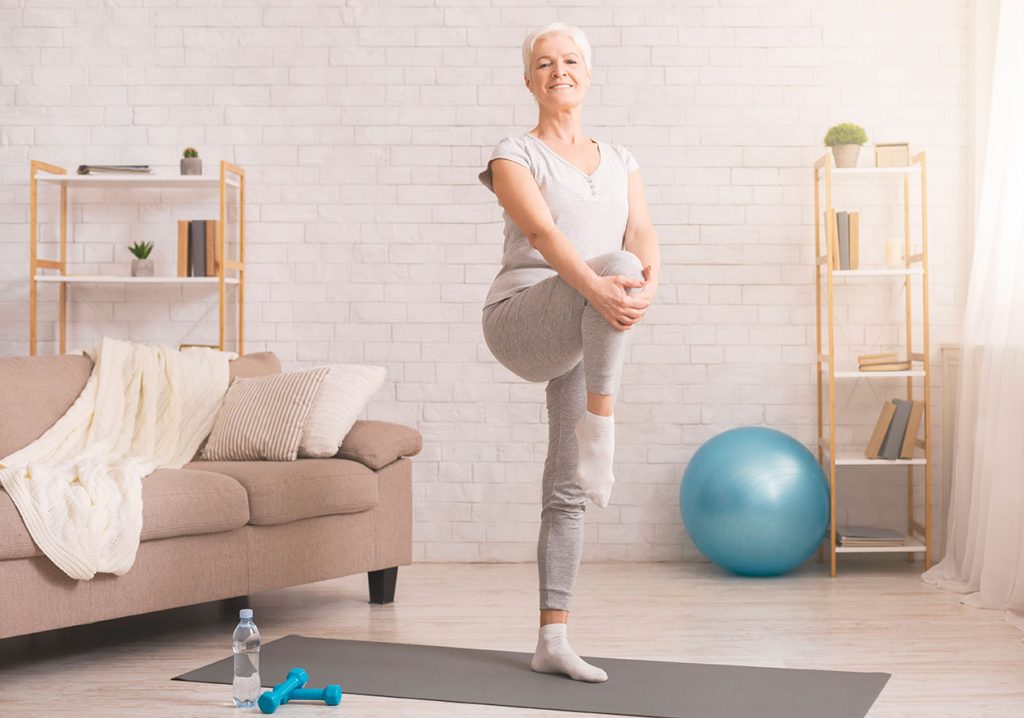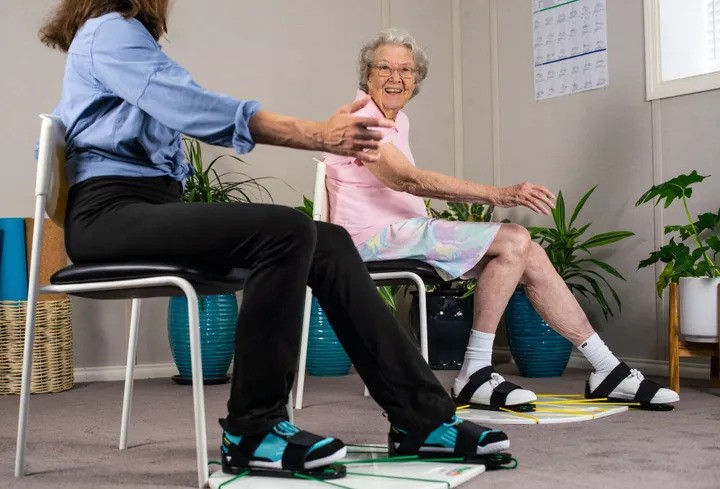It’s no secret that balance tends to decline with age. Your clients may notice they are swaying a bit more while standing and walking, or feeling weaker or less steady. We all want it, but what is balance? We need to understand what it is in order to restore what was lost, safely, effectively and efficiently.
Balance is the ability to maintain the body’s center of mass over its base of support. Your center of mass is a few inches below your belly button or can be thought of as your trunk. Your feet are your base of support (unless you are performing a handstand!)

Balance is the ability to stay upright when standing (static balance) or when moving and performing activities like walking or climbing stairs (dynamic balance). The most common question I hear from older adult clients is, “Why am I losing balance?” Let’s find out why.
What is Balance?
Balance is a sense that lives in the brain. Balance relies on information constantly flowing into the brain from three main sensory systems including our visual, vestibular and proprioceptive systems. Moving properly depends on the ability of the brain to gather and interpret the sensory information provided by eyes, ears and joints. This is essential because the brain then tells the body how to respond to stay upright and balanced.
The quality of the sensory input gathered directly impacts the quality of movement. The stronger the sensory signals sent to the brain, the more accurate the instructions sent to the body will be. On the flip side, as sensory signals become impaired, movement quality dwindles, as reaction time becomes slower.
Making Sense of Balance: The 3 Systems
Let’s explore the sensory systems that make up balance.
Visual System: Your eyes tell your brain about where your body is relative to the environment, whether you are walking inside your home, in a busy airport, or strolling on the beach. With aging eyes, a great many people don eyeglasses to function day to day, and as our eyesight weakens, so too does the quality of the sensory input.
Vestibular System: The ears relay information to the brain about the motion and position of the head to adjust posture to maintain balance. Semicircular canals in the inner ears contain fluid and tiny hair cells. As the head nods up and down, moves left to right, or tilts to the side, the fluid in the inner ear moves and the tiny hair cells sense the speed and direction the head is moving in.
By age 70, it’s typical to have lost 40% of those sensory-detecting hair cells (Zalewski 2015).
Proprioceptive System: Proprioception, literally meaning “sense of self”, is your sense of body awareness and is a prerequisite for balance. It’s how you understand the parts that make up your body, where they are located, how they feel and even what they can do. It’s the way your body communicates with itself so you can walk without looking at your feet.
Proprioceptors are sensory nerves that live in and around joints, in ligaments, joint capsules, tendons, muscles and connective tissues. They sense and send signals to the brain about joint position and motion, as well as the muscle force involved in movement.
As we age, our sense of body awareness is impaired leading to poor joint function, body alignment, control and coordination. The result: poor balance and higher risk of falling.
Losing and Restoring Balance
As our eyes, ears and joints lose their sensory capabilities, this is why balance is gradually lost.
To regain what was lost, we apply the SAID principle (Specific Adaptations to Imposed Demands) to improve function with targeted training. Up to 70% of the sensory input for balance comes from your joints (Peterka 2002), so improving joint function can be a highly efficient way to improve proprioception at any age so clients can enjoy better balance and more confidence to prevent falls.
Most Efficient Balance Training
I start each balance training session using the MoveMor® Mobility Trainer to warm up clients’ lower body, restore ankle mobility and foot stability while increasing proprioception. Clients are thrilled to experience improved functional abilities so they can save themselves in time to prevent falls.
With 12-points of resistance, MoveMor® makes it simple to restore joint flexibility and strength in less time than any other tool, all from a safely seated position! This wakes up proprioceptive sensory nerves essential for balance while stimulating motor nerves for quicker reflexes.

You can get started with training clients on their journey to feeling steadier, stronger and more confident by visiting MoveMor.com/exercise-programs. There are 7 exercise programs to choose from that vary in length from 5-30 minutes. Our Take 10 to MoveMor exercise program is proven to improve balance, ankle flexibility, strength and more in just 10 minutes! An exercise guide makes it simple to identify weaknesses and tailor exercises.
MoveMor® seamlessly integrates into your balance and fall prevention training to accelerate functional outcomes and satisfaction so your clients can enjoy better balance and an extra spring in their step today!
Cate Reade, MS, RD is a Registered Dietitian, Exercise Physiologist and Functional Medicine Practitioner candidate on a mission to improve functional mobility and health span utilizing the power of lifestyle medicine. She has been teaching, writing and prescribing healthy eating and exercise programs for over 25 years. Today, as CEO of Resistance Dynamics and inventor of the MoveMor™ Mobility Trainer, she develops exercise products and programs that target joint flexibility, strength and balance deficits to help older adults fall less and live more.
